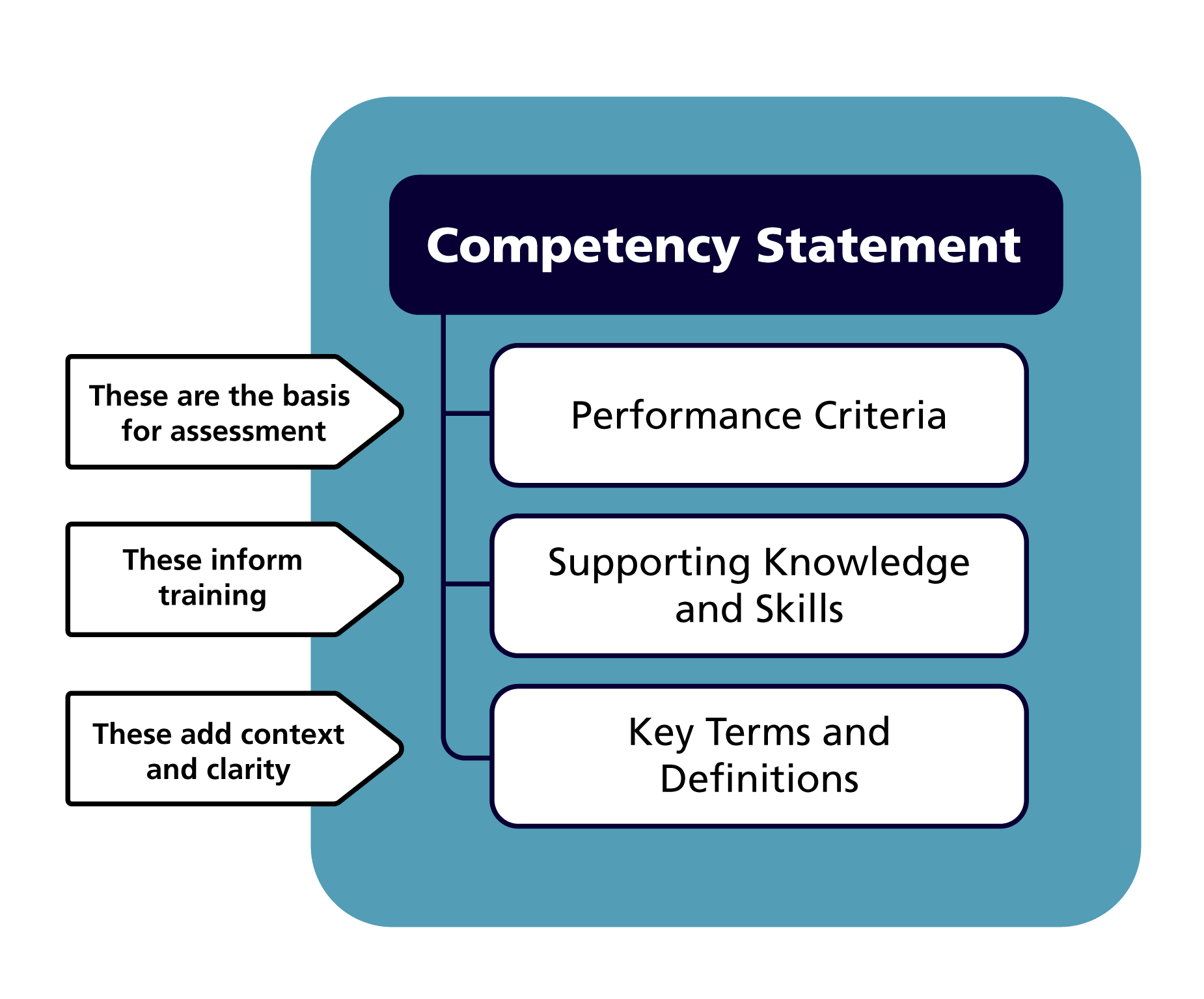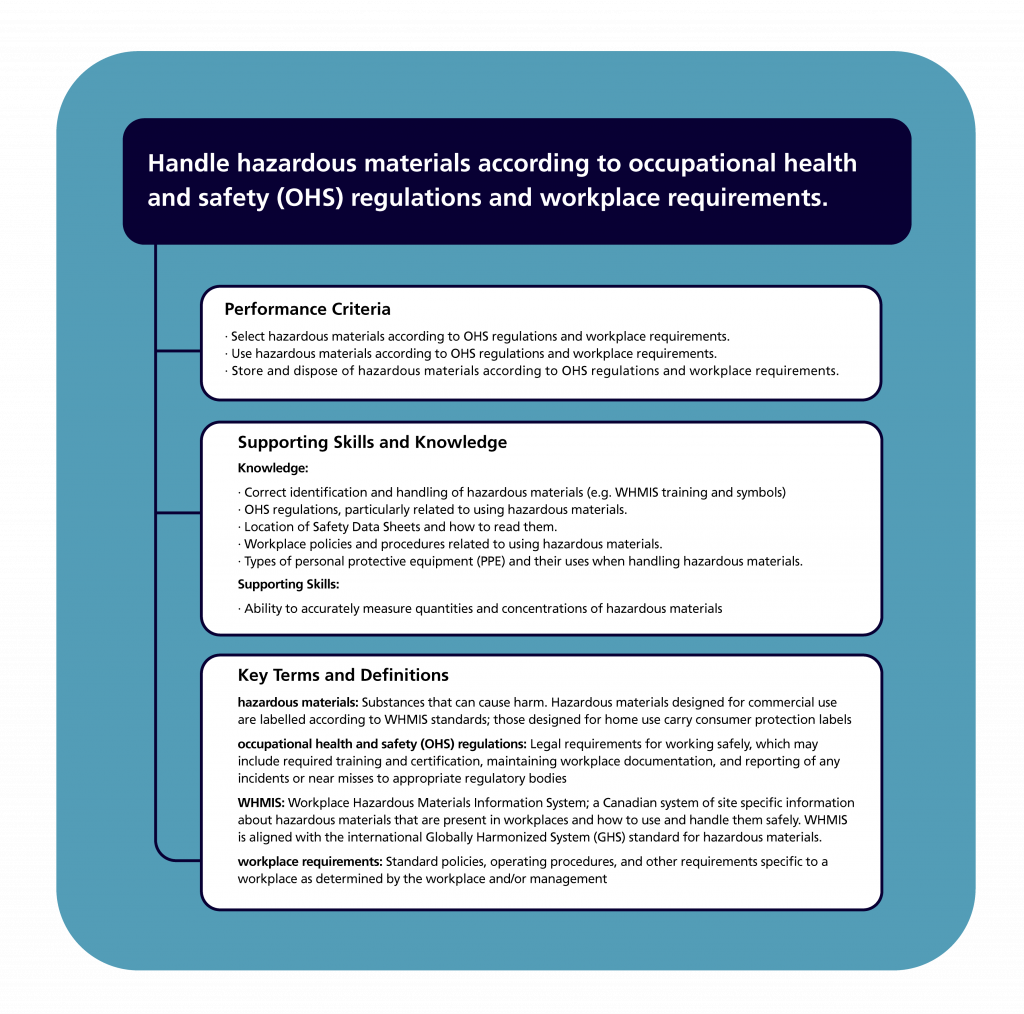4 What are competencies?
A competency describes the ability to use a set of related knowledge, skills, and attributes required to successfully perform activities and tasks in a defined setting. This might seem straightforward but there is no agreed upon definition of competency. As the workplace and educational sectors debate the use of the term, we are going to propose some definitions that will help you build a competency framework.
For the purposes of this toolkit and for clarity, we differentiate between:
- competency frameworks, which include hierarchical groups or clusters of competencies ( competency groupings), and
- individual, well defined competencies.
When using this toolkit, we will refer to individual competencies (or a competency) as consisting of:
- a defined competency statement and
- its supporting information, or description.
While this interpretation is far from universal, it lays the groundwork for using competencies as a foundational piece of a competency framework.

Components of Competencies
Competencies are comprised of some key components:
- A competency statement which outlines the context and criteria/standards for the expected performance.
- Performance criteria which are measurable outcomes required to demonstrate proficiency of the competency.
- Supporting information which includes the required supporting knowledge and skills to be able to achieve the competency.
- Key terms that are open to interpretation.
Take a moment to review the sample competency below which includes examples for each of the structural components.

Show/Hide alternative (text) version of the competency example in the image above
Competency Statement:
Handle hazardous materials according to Occupational Health and Safety (OHS) regulations and workplace requirements.
Performance Criteria:
- Participate in required training for handling hazardous materials (e.g WHMIS training) according to OHS regulations and workplace requirements
- Select hazardous materials according to OHS regulations and workplace requirements
- Use hazardous materials according to OHS regulations and workplace requirements
- Store and dispose of hazardous materials according to OHS regulations and workplace requirements
Supporting Knowledge and Skills:
Knowledge:
- Correct identification and handling of hazardous materials (e.g. WHMIS training and symbols)
- OHS regulations, particularly related to using hazardous materials
- Location of Safety Data Sheets and how to read them
- Workplace policies and procedures related to using hazardous materials
- Types of personal protective equipment (PPE) and their uses when handling hazardous materials
Skills:
- Ability to accurately measure quantities and concentrations of hazardous materials
Key Terms and Definitions for this Competency:
| hazardous materials | Substances that can cause harm. Hazardous materials designed for commercial use are labelled according to WHMIS standards; those designed for home use carry consumer protection labels |
| occupational health and safety (OHS) regulations | Legal requirements for working safely, which may include required training and certification, maintaining workplace documentation, and reporting of any incidents or near misses to appropriate regulatory bodies |
| WHMIS | Workplace Hazardous Materials Information System; a Canadian system of site specific information about hazardous materials that are present in workplaces and how to use and handle them safely. WHMIS is aligned with the international Globally Harmonized System (GHS) standard for hazardous materials. |
| workplace requirements | Standard policies, operating procedures, and other requirements specific to a workplace as determined by the workplace and/or management |
A combination of well-defined competencies and hierarchical information on how competencies are grouped and connected to work activities, job roles, assessments and more for various applications.
A set of more than one defined competencies that create a larger component within a competency framework or for a particular use. Competency groupings may be hierarchical and have several layers of sub-groupings, and a single competency may be included in many different groupings.
The specific and measurable combination of knowledge, skills and attributes that result in the performance of an activity or task to a defined level of expectation or performance standard.
A descriptive statement that states what a competent individual is doing, and in what context
measurable outcomes required to demonstrate proficiency in the competency
The underlying things you must know and be able to do in order to demonstrate the competency. Knowledge and skills alone are not enough to demonstrate competence; they must be applied together within the context of the activity being undertaken.

